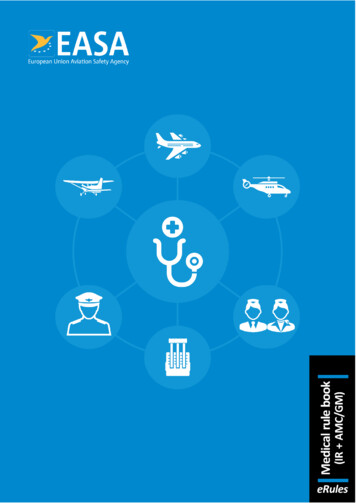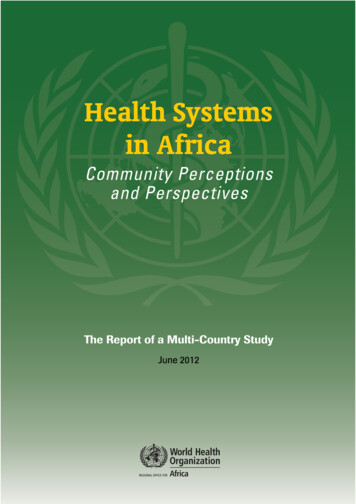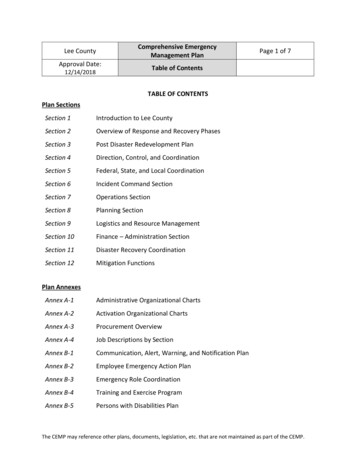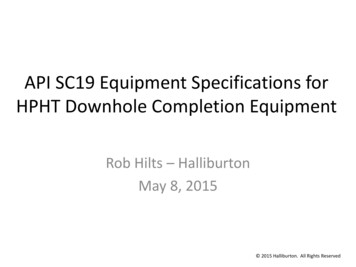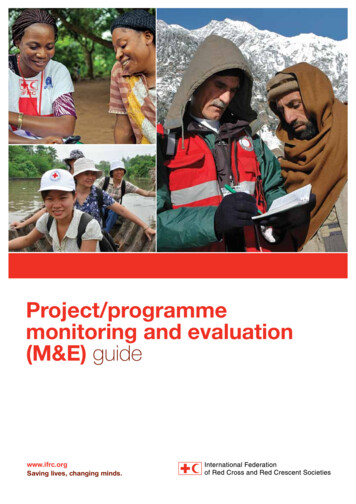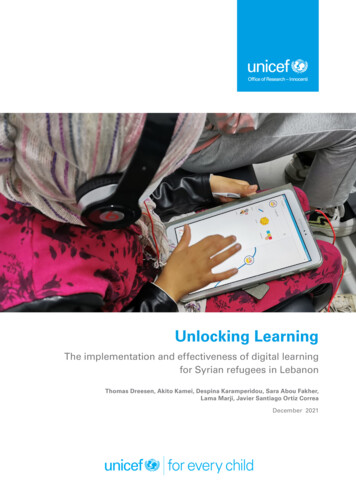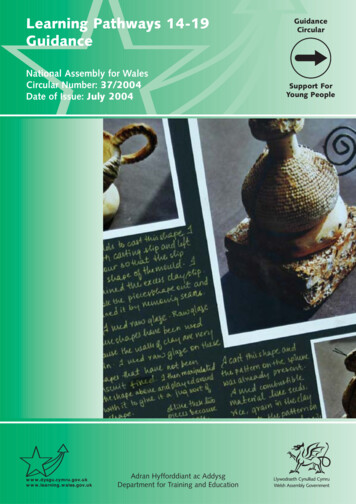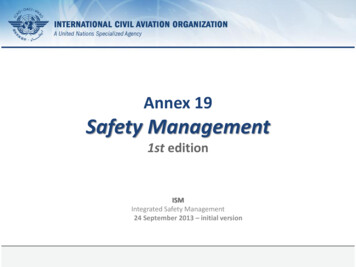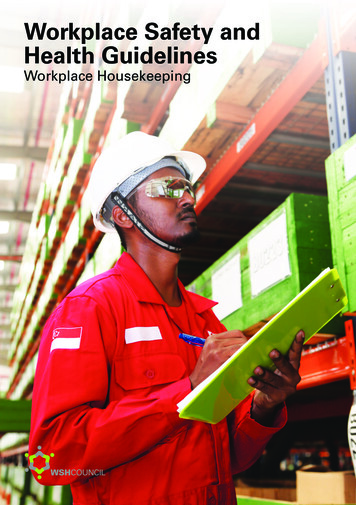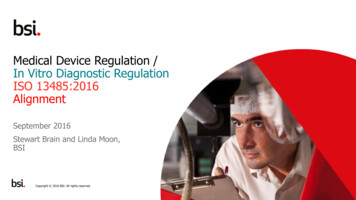
Transcription
2016 Annex to theModel Aquatic Health CodeScientific Rationale2nd Edition, July 2016CS264311A
Annex to the 2016 Model Aquatic Health CodeSCIENTIFIC RATIONALEPosted on 07/15/2016This information is distributed solely as guidance for the purpose ofassisting state and local health departments, aquatic facility inspectionprograms, building officials, the aquatics industry, and other interestedparties in improving the health and safety at public aquatic facilities.This document does not address all health and safety concernsassociated with its use. It is the responsibility of the user of thisdocument to establish appropriate health and safety practices anddetermine the applicability of regulatory limitations prior to each use.
2016 MAHCForewordiiANNEXForewordSwimming, soaking, and playing in water have been global pastimes throughout writtenhistory. Twentieth-century advances in aquatics—combining disinfection, recirculation,and filtration systems—led to an explosion in recreational use of residential and publicdisinfected water. As backyard and community pool use has swept across the UnitedStates, leisure time with family and friends around the pool has increased. Advances inpublic aquatic facility design have pushed the horizons of treated aquatic facilities fromthe traditional rectangular community pool to the diverse multi-venue waterpark hostingtens of thousands of users a day. The expansion of indoor aquatic facilities has made thepool and waterpark into year-round attractions. At the same time, research hasdemonstrated the social, physical, and psychological benefits of aquatics for all agegroups.However, these aquatics sector changes—combined with changes in the generalpopulation, chlorine-tolerant pathogens, and imperfect bather hygiene—have resulted insignificant increases in reports of waterborne outbreaks, with the greatest increaseoccurring in man-made disinfected aquatic venues. Drowning continues to claim the livesof far too many, especially children, and thousands of people visit hospitals every yearfor pool chemical-related injuries. The increase in outbreaks and continued injuriessuggests there would be benefits from building stronger public health regulatory programsand supporting them with strong partnerships to implement health promotion efforts,conduct research, and develop prevention guidance. It also would be useful for publichealth officials continue to play a strong role in overseeing design and construction,advising on operation and maintenance, and helping inform policy and management.The Model Aquatic Health Code (MAHC) is a set of voluntary guidelines based on scienceand best practices that were developed to help programs that regulate public aquaticfacilities reduce the risk of disease, injury, and drowning in their communities. The MAHCis a leap forward from the Centers for Disease Control and Prevention’s (CDC)operational and technical manuals published in 1959, 1976, and 1981 and a logicalprogression of CDC’s Healthy Swimming Program started in 2001. The 2016 MAHCunderscores CDC’s long-term involvement and commitment to improving aquatic healthand safety. The MAHC guidance document stemmed from concern about the increasingnumber of pool-associated outbreaks starting in the mid-1990s. Creation of the MAHCwas the major recommendation of a 2005 national workshop held in Atlanta, Georgiacharged with developing recommendations to reduce these outbreaks. Federal, state,and local public health officials and the aquatics sector formed an unprecedentedcollaboration to create the MAHC. The MAHC will be regularly updated using input froma national stakeholder partnership called the Council for the Model Aquatic Health Code(CMAHC). The CMAHC was formed to keep the MAHC up to date and current with thelatest advances in the aquatics industry while also responding to public health reports ofdisease and injury. The partnership hopes this truly will lead to achieving the MAHC visionof “Healthy and Safe Aquatic Experiences for Everyone” in the future.Atlanta GA 2016
2016 MAHCAcknowledgementsiiiANNEXAcknowledgmentsThe 2016 MAHC utilized the first time CMAHC conference process to collect, assess, andrelay MAHC Change Request recommendations to CDC. The first CMAHC Vote on theCode Biennial Conference was held October 6-7, 2015 in Phoenix Arizona, a little overone year after CDC’s release of the 2014 MAHC, 1st Edition. CDC utilized CMAHC’s inputto revise the MAHC and plans to utilize the CMAHC conference process to update futureversions of the MAHC. CDC would like to acknowledge the hard work and dedication ofthe CMAHC Executive Director, CMAHC Technical Review Committee, CMAHC Boardof Directors, and CMAHC membership for developing and implementing the 1st CMAHCconference process. It is only through the dedicated efforts and contributions ofexperienced professionals that a scientifically sound, well-focused, and up-to-date MAHCis possible. CDC acknowledges with immense gratitude the substantial assistance ofthose who contributed to public health and aquatic safety in the development of the 2016MAHC. They deserve our heartfelt thanks and appreciation for volunteering their time,energy, and creativity to create the 2016 MAHC. In addition, we would like to also giveour thanks to all the reviewers across the country who provided public comments, andspent a great deal of time combing through the detail of the MAHC code and annex tosubmit Change Requests for improvement. Their effort was worth the time investment;the MAHC was greatly improved after the Conference process and associated publiccomment periods.CMAHC Executive DirectorDoug SackettCMAHC Board of DirectorsMichael Beach, President,Tracynda Davis, Vice President,Bob Vincent, SecretaryScott Hunsaker, TreasurerJim DunnJohn LinnColleen MaitozaTony MendezTim ShayJasen KunzCMAHC Technical ReviewCommitteeCarl Nylander, ChairmanPaul Sisson, Vice ChairmanEllen MeyerRich MartinRalph KittlerSusan PaintingKatie MooreGary FraserLaura SuppesCDC Employees &ContractorsKate AwsumbMichael BeachMaggie ByrneJulia CharlesElaine Curtiss, ContractorKelli FosterCAPT Julie GilchristMichele HlavsaHeather HortonJon KennonCDR Jasen KunzMontrece RansomJohn SariskyTeresa Sims, ContractorPam Wigington
2016 MAHCTable of ContentsivANNEXTable of ContentsForeword . iiAcknowledgments. iiiCMAHC Executive Director .iiiCMAHC Board of Directors .iiiCMAHC Technical Review Committee .iiiCDC Employees & Contractors .iiiTable of Contents . iv1.0Preface . 171.1 Introduction . 171.1.1 Rationale . 171.2 Recreational Water-Associated Illness Outbreaks and Injuries . 171.2.1 RWI Outbreaks . 171.2.2 Significance of Cryptosporidium . 181.2.3 Drowning and Injuries . 191.2.4 Pool Chemical-Related Injuries . 191.3 Model Aquatic Health Code . 191.3.1 Background . 191.4Public Health and Consumer Expectations . 201.5 Advantages of Uniform Guidance . 201.5.1 Sector Agreement. 201.6Modifications and Improvements in the 2016 MAHC . 201.7 MAHC Adoption at State or Local Level . 201.7.1 MAHC Adoption at State or Local Level . 201.8 The MAHC Revision Process . 211.8.1 MAHC Revisions . 212.0User Guide . 222.1Overview . 222.2MAHC Structure and Format . 222.3 Annex . 222.3.1 Scientific and Best Practices Rationale . 222.3.2 Content . 223.0Glossary of Acronyms, Initialisms, and Terms Used in the MAHC Annex . 233.1Glossary of Acronyms and Initialisms Used in the MAHC Annex . 233.2Glossary of Terms Used in the MAHC Annex . 24
2016 MAHC3.34.0Table of ContentsvANNEXGlossary of Codes, Standards, Laws Cited in the MAHC Annex . 37Aquatic Facility Design Standards and Construction . 444.0.1 Basic Design Considerations for Handling Particle Contamination Burden,Chlorine and Disinfectant Demand, and Disinfection By-Product Issues . 444.0.1.1 Particle Contamination Burden. 444.0.1.2 Disinfectant Demand . 444.0.1.3 Chlorine Disinfectant Demand. 454.0.1.4 Disinfection By-Product Issues. 464.1 Plan Submittal . 514.1.1 Plan Submittal . 514.1.2 Content of Design Report . 514.1.2.1 Basis of Design Report . 514.1.2.3 Technical Specifications . 514.1.3 Plan Approval . 534.1.3.3 Replacements . 534.1.4 Compliance Certificate . 534.1.4.4 Systems Commissioning . 534.2 Materials . 544.2.1 Aquatic Venues . 544.2.1.5 Design Parameters . 544.2.1.7 Smooth Finish . 544.2.1.8 Slip Resistant . 544.2.2 Indoor Aquatic Facility . 544.2.2.2 Condensation Prevention . 544.2.2.3 Mechanical Systems . 554.2.2.4 Indoor Aquatic Facility Doors . 554.2.2.5 Indoor Aquatic Facility Windows . 554.3 Equipment Standards . 554.3.1 General . 554.3.1.1 Accredited Standards . 554.3.2 Recirculation Systems and Equipment . 56Inlets. 57Overflow System / Gutters . 57Skimmers . 57Main Drain System . 57Multiport Valves . 57Face Piping . 57Diaphragm Valves . 57Check Valves . 57Fittings . 57Pipe. 58Pumps . 58Strainers . 58Gauges . 58
2016 MAHCTable of ContentsviANNEXFlow Meters . 58HVAC and Dehumidifiers . 58Solar Pool Heaters . 58Furnaces . 58Boilers . 58Gas-Fired Pool Heaters . 59Flues. 59Rapid Sand Filters . 59High-Rate Sand Filters . 59Precoat Filters . 59Filter Media. 59Cartridge Filters . 59Other Filter Types. 59Mechanical Chemical Feeding Equipment . 59Ozone . 60Ultraviolet Light. 60In-line Electrolytic Chlorinator . 60Brine Batch Electrolytic Chlorine or Bromine Generator. 60Copper/Silver and Copper Ion Generator . 60Chemical Storage . 60Automated Controllers . 60Water Quality Testing Device . 60National Electrical Code . 61Lights. 61Diving Boards and Platforms . 61Starting Blocks . 61Life Guard Chairs . 61Ladders . 61Handrail . 61Stairs. 61Handicapped Lifts. 61Safety Covers . 614.4Aquatic Facility and Venue Operation Maintenance [N/A] . 624.5 Aquatic Venue Structure. 624.5.1 Design for Risk Management . 624.5.2 Bottom Slope . 624.5.2.1 Under Five Feet . 624.5.2.3 Drain . 624.5.3 Pool Access / Egress. 624.5.3.1 Accessibility. 624.5.4 Stairs . 624.5.4.3 Deep Water . 624.5.4.5 Dimensions . 634.5.4.8 Perimeter Gutter Systems . 644.5.5 Handrails . 644.5.5.3 Upper Railing . 64
2016 MAHCTable of ContentsviiANNEX4.5.5.5 ADA Accessibility . 644.5.5.7 Dimensions . 644.5.6 Grab Rails . 654.5.7 Recessed Steps . 654.5.7.4 Dimensions . 654.5.8 Ladders . 674.5.8.1 General Guidelines for Ladders . 674.5.8.2 Ladder Handrails . 674.5.9 Zero Depth (Sloped) Entries . 674.5.10 Disabled Access . 674.5.10.1 Conform to ADA Standards . 674.5.11 Color and Finish . 674.5.11.1 White or Light Pastel . 674.5.12 Walls . 684.5.12.4 No Projections . 684.5.13 Structural Stability. 694.5.14 Hand Holds . 694.5.15 Infinity Edges . 694.5.15.1 Perimeter Restrictions . 694.5.15.3 Handholds . 704.5.15.6 Maximum Height . 704.5.16 Underwater Benches . 704.5.16.1 Slip Resistant . 704.5.16.3 Maximum Water Depth . 704.5.17 Underwater Ledges . 704.5.17.1 Slip Resistant . 704.5.17.3 Five Feet or Greater . 714.5.17.4 Structural Support . 714.5.18 Underwater Shelves . 714.5.19 Depth Markers and Markings . 714.5.19.1 Location . 714.5.19.2 Construction / Size . 714.5.19.4 No Diving Markers. 724.5.19.5 Depth Marking at Break in Floor Slope . 744.5.19.6 Dual Marking System . 744.5.19.8 Wading Pool Depth Markers . 744.5.20 Aquatic Venue Shell Maintenance [N/A] . 744.5.21 Special Use Aquatic Venues . 744.6 Indoor / Outdoor Environment . 754.6.1 Lighting . 754.6.1.2 Windows / Natural Light . 754.6.1.3 Light Levels . 754.6.1.4 Overhead Lighting . 754.6.1.5 Underwater Lighting . 754.6.1.6 Night Swimming with No Underwater Lights . 774.6.1.7 Emergency Lighting . 77
2016 MAHCTable of ContentsviiiANNEX4.6.1.8 Glare . 774.6.2 Indoor Aquatic Facility Ventilation. 774.6.2.1 Purpose. 784.6.2.2 Exemptions . 804.6.2.5 ASHRAE 62.1 Compliance . 804.6.2.6 Air Handling System Design. 814.6.2.7 Performance Requirements for Air Handling Systems . 844.6.3 Indoor / Outdoor Aquatic Facility Electrical Systems and Components . 874.6.3.1 General Guidelines . 874.6.3.2 Electrical Equipment in Interior Chemical Storage Spaces . 894.6.4 Pool Water Heating . 914.6.4.1 High Temperature . 934.6.4.4 Equipment Room Requirements . 944.6.5 First Aid Area . 944.6.5.1 Station Design . 944.6.6 Emergency Exit . 944.6.7 Drinking Fountains. 944.6.7.1 Provided . 944.6.8 Garbage Receptacles . 954.6.9 Food and Drink Concessions . 954.6.10 Spectator Areas . 954.6.10.2 Deck. 954.6.10.3 Balcony . 954.6.10.4 Bleachers . 954.7 Recirculation and Water Treatment . 954.7.1 Recirculation Systems and Equipment . 954.7.1.1 General . 954.7.1.2 Combined Aquatic Venue Treatment . 964.7.1.3 Inlets . 974.7.1.4 Perimeter Overflow Systems/Gutters . 994.7.1.5 Skimmers and Alternative Gutter Technologies Using In-Pool SurgeCapacity . 1014.7.1.6 Submerged Suction Outlet . 1034.7.1.7 Piping . 1044.7.1.8 Strainers and Pumps . 1064.7.1.9 Flow Measurement and Control . 1074.7.1.10 Flow Rates / Turnover . 1084.7.2 Filtration . 1154.7.2.2 Granular Media Filters . 1234.7.2.3 Precoat Filters . 1334.7.2.4 Cartridge Filters. 1344.7.3 Disinfection and pH Control . 1354.7.3.2 Feed Equipment .
Code Biennial Conference was held October 6-7, 2015 in Phoenix Arizona, a little over one year after CDC's release of the 2014 MAHC, 1st Edition. CDC utilized CMAHC's input to revise the MAHC and plans to utilize the CMAHC conference process to update future versions of the MAHC. CDC would like to acknowledge the hard work and dedication of

